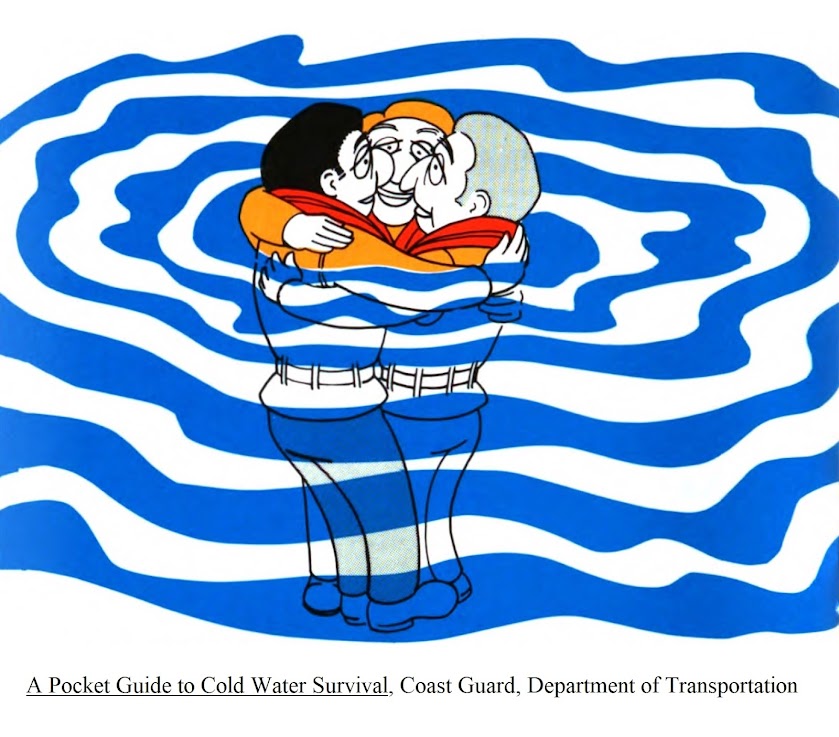“You’re in hot water!”, the
Oxford Language dictionary defines this phrase as you’re “in a situation of
difficulty, trouble”, everyone knows that, right?1 But in the wilderness, how often are you
threatened with hot water? Probably not that often.
In the wilderness the phrase ought to be changed to, “you’re in cold
water, and being wet kills, fast!”
And don’t forget the “120o Rule”, for more on this read
“The 120 Degree Rule ©”, HERE.
Being wet or in cold water can kill
you, as it quickly causes hypothermia, a condition where your body can not
produce or conserve enough heat to survive.
But what can you do to prevent this condition from progressing to the
point where you die?
There are two major ways that someone
in cold water loses body heat -- conduction and convection. Conduction is when body heat is lost directly
to the environment by direct contact and convection is when body heat is lost
by moving water or air.
Conduction...
Convection...
Dress in layers...
Just like dressing in layers can
protect you from the cold on land, it can protect you if you end up in the
water. The layers will help keep the
body-warmed water near your skin and prevent it from drifting away because of
convection, as long as you stay still, that is.
Also, keeping your head covered with a hood or a knit cap will help keep
you warm and increase your survival time.
Don’t swim for it!
Because of convection and conduction,
in cold water you cannot stay alive long by treading water or swimming for it. In cold water survival situations, swimming,
or treading water, simply hastens your death by hypothermia. This is because, as you swim or tread water,
blood is forced from your core to the large muscles of the upper body and limbs,
where it is quickly cooled by conduction, as it flows through
the arteries close to your skin, and by convection, as you move and force the
water to flow past you. And even if
you are treading water slowly, just enough to keep afloat, you will cool about
35% faster than if you floated motionless.
By wearing a flotation device and remaining
still, rather than swimming, you can increase your survival time by about 33%. Also, in a cold water survival situation, don’t
use the drownproofing technique of lowering the head into the water and then
gently raising it to breathe2, because by
getting your head wet you will cool 82% faster than if you floated with your
head and neck above the water.
The hands have it...
As you get colder, and the temperature
of your hands drops closer to the water temperature, the
dexterity of your hands will drop off quickly. The colder the water, the faster this
happens. In cases of total body
immersion in water that is 32o F (0o C), you can lose
hand dexterity in less than a minute! Your
hand dexterity is first affected when your hands skin temperature drops to 55
to 65o F (13 to 18o C).
At a hand skin temperature of 50o F (10o C), you will
experience numbness and diminished feeling, your ability to tie and untie knots
will fall by 25% and your grip strength decreases by as much as 50%.
Windchill...
And don’t forget to put some type of
insulating material underneath you when you sit, to lessen convective heat loss
to the ground, or the water below the raft, depending on whether you have made
it to shore or are out on the water still.
Remember being wet kills, fast!
Don’t forget to come back next week and read “Building a WWII
Emergency Sustenance Vest, Type C-1, Part Three©”, where we will talk about how
to build a survival match box like the DuPage Path-Pilot Compass camp.
I
hope that you continue to enjoy The Woodsman’s Journal Online and look for me
on YouTube at BandanaMan Productions for other related videos, HERE. Don’t forget to follow me on both The
Woodsman’s Journal Online, HERE,
and subscribe to BandanaMan Productions on YouTube. If you have questions, as always, feel free
to leave a comment on either site. I
announce new articles on Facebook at Eric Reynolds, on Instagram at
bandanamanaproductions, and on VK at Eric Reynolds, so watch for me.
That
is all for now, and as always, until next time, Happy Trails!
Notes
1
Oxford Languages, HERE
2
The drownproofing technique is a warm water survival tip, to use to conserve
energy when you are not wearing a personal flotation device.
Sources
Coast Guard, Department
of Transportation, A Pocket Guide to Cold Water
Survival, CG 473, September 1975, https://books.googleusercontent.com/books/content?req=AKW5QafxNJBmiIml6O4jiudRpr2rz8pLfodQOiq-4gZNh4xa5uIN_rq05C2yAes1AYw67Ziq189QaQaFDHBHE0SJivfCxjMW1DReANLjFqw1qX6jEl2mz1HPKXj4BRQJv8zAOcO6oDE70Dcv__VE2uPh4tEqLSzMxDRiWOv3p6ssyQjE2bevJMX7-Ol2KDtIPQVcVuaJudJMLaOOuSUVs8qYS1Nlaxnm47GVOCXLR79KzL6nV3R0zZG4DxRt9hoYrIRGugXm6RVfbU2gxeix7JLKbxpvQsNB9w,
accessed May 1, 2022
Oxford
Languages, https://www.google.com/search?q=your+in+hot+water&oq=your+in+hot+water&aqs=chrome..69i57j0i22i30l7j0i390i650l2.4735j1j15&sourceid=chrome&ie=UTF-8,
accessed May 5, 2023
Warren, Elizabeth G.,
SSGT.; “Hypothermia Missing in the Atlantic”, Flying Safety, November
1983, pages 12-15, https://books.google.com/books?id=gDd8qzWSi4YC&pg=RA1-PA7&dq=airplane+crash+survival&hl=en&newbks=1&newbks_redir=0&sa=X&ved=2ahUKEwjWz5PUgMb9AhVVEVkFHTulDlI4FBDoAXoECAIQAg#v=onepage&q=airplane%20crash%20survival&f=false,
accessed May 6, 2023















No comments:
Post a Comment